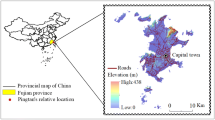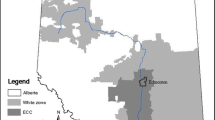Abstract
This paper employed geographically weighted regression (GWR) to characterize the determinants of farmland conversion at administrative scale between 1994 and 2003 across Qiantang watershed, China. Six determinants were identified: total area of forest, distance to highway, distance to second road, distance to river, population, and gross domestic product. Relationships between these identified determinants and farmland conversion showed great spatial non-stationarity, since their character, nature, and strength varied significantly across space. Typically, for cities whose development was heavily relied on road infrastructure development, the impacts of “distance to second road” and “distance to river” was negative. However, in mountainous areas, the restriction of terrain factors led to positive impacts from these two variables. For areas undergoing rapid socio-economic development, farmland conversion was accelerated by population growth and economic development. However, for more urbanized regions, a slow-down rate of farmland conversion would be expected. Our study highlighted that the problem of spatial non-stationarity should be addressed when qualifying the determinants of farmland conversion. Linking our results within the context of farmland protection, we argue that implementing local-specific land management practices, instead of the current one-size-fits-all framework, is the key for the success of farmland protection in China.






Similar content being viewed by others
References
Basu P, Chakraborty J (2008) The other side of sprawl: a county-level analysis of farm loss in Florida. Southeast Geogr 48:219–248
Busch G (2006) Future European agricultural landscapes—what can we learn from existing quantitative land use scenario studies? Agric Ecosyst Environ 114:121–140
Clement F, Orange D, Williams M, Mulley C, Epprecht M (2009) Drivers of afforestation in Northern Vietnam: assessing local variations using geographically weighted regression. Appl Geogr 29:561–576
Deng X, Huang J, Rozelle S, Uchida E (2006) Cultivated land conversion and potential agricultural productivity in China. Land Use Policy 23:372–384
Ding S (2003) Land policy reform in China: assessment and prospects. Land Use Policy 20:109–120
Doygun H (2009) Effects of urban sprawl on agricultural land: a case study of Kahramanmaraş, Turkey. Environ Monit Assess 158:471–478
Fotheringham AS, Brunsdon C, Charlton ME (2002) Geographically weighted regression: the analysis of spatially varying relationships. Wiley, Chichester
Fox J, Vogler JB, Sen OL, Giambelluca TW, Ziegler AD (2012) Simulating land-cover change in Montane mainland Southeast Asia. Environ Manage 49:968–979
Han S, He C (1999) Diminishing farmland and urban development in China: 1993–1996. GeoJournal 49:257–267
Huang S, Wang S, Budd WW (2009) Sprawl in Taipei’s peri-urban zone: responses to spatial planning and implications for adapting global environmental change. Landsc Urban Plan 90:20–32
Kam SP, Hossain M, Lal Bose M, Villano LS (2005) Spatial patterns of rural poverty and their relationship with welfare-influencing factors in Bangladesh. Food Policy 30:551–567
Kuemmerle T, Hostert P, Radeloff VC, van der Linden S, Perzanowski K, Kruhlov I (2008) Cross-border comparison of post-socialist farmland abandonment in the Carpathians. Ecosystems 11:614–628
Levia DF (1998) Farmland conversion and residential development in north central Massachusetts. Land Degrad Dev 9:123–130
Liao FHF, Wei YHD (2012) Modeling determinants of urban growth in Dongguan, China: a spatial logistic approach. Stoch Environ Res Risk Assess. doi:10.1007/s00477-012-0620-y
Lichtenberg E, Ding C (2008) Assessing farmland protection policy in China. Land Use Policy 25:59–68
Lin C, Ho P (2003) China’s land resources and land-use change: insights from the 1996 land survey. Land Use Policy 20:87–107
Liu J, Liu M, Tian H, Zhuang D, Zhang Z, Zhang W, Tang X, Deng X (2005) Spatial and temporal patterns of China’s cropland during 1990–2000: an analysis based on Landsat TM data. Remote Sens Environ 98:442–456
Long H, Liu Y, Wu X, Dong G (2009) Spatio-temporal dynamic patterns of farmland and rural settlements in Su-Xi-Chang region: implications for building a new countryside in coastal China. Land Use Policy 26:322–333
Łowicki D (2008) Land use changes in Poland during transformation case study of Wielkopolska region. Landsc Urban Plan 87:279–288
Luo J, Wei Y (2009) Modeling spatial variations of urban growth patterns in Chinese cities: the case of Nanjing. Landsc Urban Plan 91:51–64
Meij HV, Rheenen TV, Tabeau A, Eickhout B (2006) The impact of different policy environments on agricultural land use in Europe. Agric Ecosyst Environ 114:21–38
Ogneva-Himmelberger Y, Pearsall H, Rakshit R (2009) Concrete evidence & geographically weighted regression: a regional analysis of wealth and the land cover in Massachusetts. Appl Geogr 29:478–487
Polimeni JM (2005) Simulating agricultural conversion to residential use in the Hudson River Valley: scenario analyses and case studies. Agric Hum Values 22:377–393
Powell R, Roberts D, Dennison P, Hess L (2007) Sub-pixel mapping of urban land cover using multiple endmember spectral mixture analysis: Manaus, Brazil. Remote Sens Environ 106:253–267
Rounsevell MDA, Annetts JE, Audsley E, Mayr T, Reginster I (2003) Modelling the spatial distribution of agricultural land use at the regional scale. Agric Ecosyst Environ 95:465–479
Skinner MW, Kuhn RG, Joseph AE (2001) Agricultural land protection in China: a case study of local governance in Zhejiang Province. Land Use Policy 18:329–340
Su S, Jiang Z, Zhang Q, Zhang Y (2011a) Transformation of agricultural landscapes under rapid urbanization: a threat to sustainability in Hang-Jia-Hu region, China. Appl Geogr 31:439–449
Su S, Zhang Q, Zhang Z, Zhi J, Wu J (2011b) Rural settlement expansion and paddy soil loss across an ex-urbanizing watershed in eastern coastal China during market transition. Reg Environ Change 11:651–662
Su S, Xiao R, Zhang Y (2012a) Multi-scale analysis of spatially varying relationships between agricultural landscape patterns and urbanization using geographically weighted regression. Appl Geogr 32:360–375
Su S, Xiao R, Jiang Z, Zhang Y (2012b) Characterizing landscape pattern and ecosystem service value changes for urbanization impacts at an eco-regional scale. Appl Geogr 34:295–305
Tan M, Li X, Xie H, Lu C (2005) Urban land expansion and arable land loss in China-a case study of Beijing–Tianjin–Hebei region. Land Use Policy 22:187–196
Tan R, Beckmann V, den Berg LV, Qu FT (2009) Governing farmland conversion: comparing China with the Netherlands and Germany. Land Use Policy 26:961–974
Thapa RB, Murayama Y (2010) Drivers of urban growth in the Kathmandu valley, Nepal: examining the efficacy of the analytic hierarchy process. Appl Geogr 30:70–83
Tu J (2011) Spatial variations in the relationships between land use and water quality across an urbanization gradient in the Watersheds of Northern Georgia, USA. Environ Manag. doi:10.1007/s00267-011-9738-9
Tu J, Xia Z (2008) Examining spatially varying relationships between land use and water quality using geographically weighted regression I: model design and evaluation. Sci Total Environ 407:358–378
van Doorn AM, Bakker MM (2007) The destination of arable land in a marginal agricultural landscape in South Portugal: an exploration of land use change determinants. Landscape Ecol 22:1073–1087
Wu J, Cheng X, Xiao H, Wang H, Yang L, Ellis EC (2009) Agricultural landscape change in China’s Yangtze Delta, 1942–2002: a case study. Agric Ecosyst Environ 129:523–533
Xie Y, Mei Y, Tian G, Xing X (2005) Socio-economic driving forces of arable land conversion: a case study of Wuxian City, China. Glob Environ Change 15:238–252
Yang H (2004) Land conservation campaign in China: integrated management, local participation and food supply option. Geoforum 35:507–518
Yang H, Li X (2000) Cultivated land and food supply in China. Land Use Policy 17:73–88
Acknowledgments
We thank Editor David Stoms and three reviewers for providing professional comments that substantially improved the original manuscript. We also thank Professor S.D. DeGloria at Cornell University for giving useful advices. Funding support was partly from the National Natural Science Foundation (No. 41001202).
Author information
Authors and Affiliations
Corresponding author
Rights and permissions
About this article
Cite this article
Su, S., Xiao, R. Spatially Varying Determinants of Farmland Conversion Across Qiantang Watershed, China. Environmental Management 52, 907–916 (2013). https://doi.org/10.1007/s00267-013-0141-6
Received:
Accepted:
Published:
Issue Date:
DOI: https://doi.org/10.1007/s00267-013-0141-6




